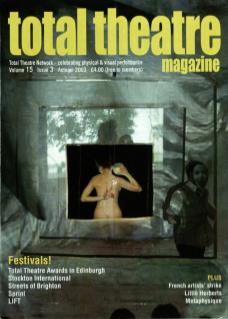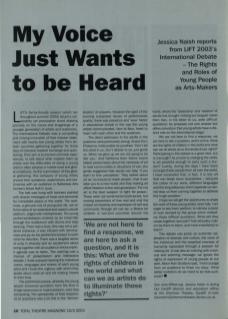LIFT's family-friendly season (which ran throughout summer 2003) struck a celebratory yet provocative chord drawing primarily on the voices and imaginings of a younger generation of artists and audiences. The International Debate was a compelling and moving invocation of that mission statement with 22 young artists from sixteen countries gathering together for three days of intensive creative exchange and questioning. Their aim is to uncover common experiences, to talk about what inspires them as artists and the difficulties of being a young artist in often adverse or hostile local and global conditions. As the culmination of this global gathering, this company of young artists shared their questions, experiences and testimonies with an audience in Battersea Arts Centre's Great Hall in June.
The hall was hung with banners painted with diverse messages of hope and demands for immediate peace in the world. The audience, a genuine mix of young and old, sat on three sides of an extended and raised catwalk platform, edged with microphones. The young performer/debaters entered as an ensemble through the auditorium with drums and step dancing. There was a buzz, this was not a polished entrance, it was infused with nervousness and joy as the performers looked to each other for direction. There was a tangible sense of unity in diversity and an excitement about being together with an audience whose explicit agenda was to listen. The evening was a mixture of presentation and interactive debate. I most enjoyed hearing the individual voices, languages and stories of each young artist and I loved the urgency with which they spoke about what art and art making means to their lives.
The performed scenes, whereby the young people answered questions from the floor in image sequences or improvisations, were less compelling. The spontaneity of their responses to questions was a bit lost in the 'demonstration' of answers. However the spirit of the evening surpassed issues of performance quality: there was presence and 'wow' factor in abundance simply in the way the young artists communicated, face to face, heart to heart with each other and the audience.
The direct addresses to the adults in the audience were particularly strong: Anand from Phakama, India pulled no punches: 'Don't kill the artist in us, don't dictate to us, just guide us. When we grow up we are not going to be like you.' And Nehlema from Sierra Leone talked passionately about the necessity of art to heal communities in situations of war; she gently suggested that adults can help ‘if you learn to love yourselves'. They talked about art as 'an excuse to reach people', that it can take you to a new world and that making art offers freedom to the next generation: ‘For me art is the best weapon to fight for peace.’ These were not sentimental testimonies, but moving expositions of how real and vital the impact of creativity and expression of self and community through art can be: a lifeline for children in war-torn countries around the world, where the ‘leadership' and 'wisdom’ of adults has brought nothing but despair. Vahid from Iran, in his letter to us, asks difficult questions; he proposes not one answer but offers conviction that young artists have a distinct role on the international stage:
‘We are not here to find a response, we are here to ask a question, and it is this: What are the rights of children in the world and what can we as artists do to illuminate those rights? Participating in this debate is a great idea, but is it enough? As a route to changing the world, is art powerful enough to carry such a burden? Luckily, during the days I have been amongst these people from all over the world, I have concluded that, in fact, it is only art that can break down boundaries – because the colour of our skins, different languages and the long distances which separate us cannot stop us from coming together to address this huge question.’
I hope we will get the opportunity to share the work of these young artists more fully. I am eager to see them perform; to witness a piece of work devised by this group which embodies these difficult questions. What will they create together next year? And will policy makers be there to listen, and most importantly to learn?
This debate was joyful, an authentic celebration of diversity and culture, the voice of the individual and the essential oneness of humanity expressed through a passion for making art. It was also an evening with a serious and sobering message: we ignore the rights of expression of young people at our peril. Alison from Scotland said, 'I find courage from an audience to finish my story.' What better invitation do we need to be that audience?
See www.liftfest.org Jessica Naish is Acting Out Cardiff director and education officer at the Sherman Theatre, Cardiff. E-mail: education@shermantheatre.demon.co.uk

